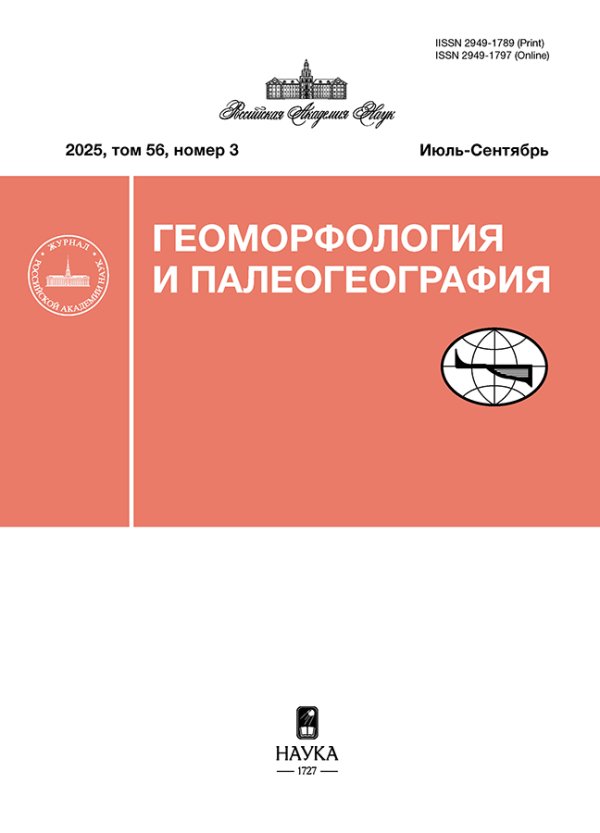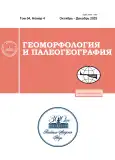LAKE VITALIEVSKOYE (VALAAM ISLAND) ISOLATION PROCESS AND VEGETATION DYNAMICS DUE TO CHANGES IN THE LEVEL OF THE LAKE LADOGA DURING THE LATE HOLOCENE1
- Authors: Sapelko T.V.1, Gazizova T.Y.1, Moiseenko A.D.2, Ludikova A.V.1, Kuznetsov D.D.1, Rusanov A.G.1
-
Affiliations:
- Institute of Limnology of the Russian Academy of Sciences, St. Petersburg Federal Research Center of the Russian Academy of Sciences
- St. Petersburg State University
- Issue: Vol 54, No 4 (2023)
- Pages: 72-89
- Section: Paleolimnological research in Russia: from Kaliningrad to Kamchatka
- URL: https://journals.rcsi.science/2949-1789/article/view/232936
- DOI: https://doi.org/10.31857/S2949178923040126
- EDN: https://elibrary.ru/XWGHCZ
- ID: 232936
Cite item
Full Text
Abstract
The macrophyte pollen is a valuable source of information about lake level changes. Continuing our previous studies on the use of the macrophytes pollen analysis in the paleolimnology we studied the Lake Vitalievskoye sediments sequence of on the Valaam Island (the northern part of Lake Ladoga). To confirm the results of pollen analysis we conducted lithological and diatom analyzes. The macrophytes distribution of the island lakes at the present time has been established with the help of geobotanical and pollen analyzes of the lacustrine surface sediments. As a result, a comprehensive study made it possible to establish the stages of the Lake Vitalievskoye development during the Late Holocene: The Lake Ladoga Bay stage with a slight overgrowth of aquatic vegetation; the lake isolation stage of the from Lake Ladoga, when macrophytes disappeared from the lake, and the lake independent development stage, when their maximum distribution occurred and later began to decline as a result of the human impact. According to our research of the Valaam Island lakes we have received new data about the modern distribution of macrophytes in the island lakes, their dynamics in the Late Holocene. We also conducted a methodological study establishing the macrophytes pollen role in studying the small island lakes history and the Lake Ladoga level.
About the authors
T. V. Sapelko
Institute of Limnology of the Russian Academy of Sciences, St. Petersburg Federal Research Centerof the Russian Academy of Sciences
Author for correspondence.
Email: tsapelko@mail.ru
Russia, St. Petersburg
T. Yu. Gazizova
Institute of Limnology of the Russian Academy of Sciences, St. Petersburg Federal Research Centerof the Russian Academy of Sciences
Email: tsapelko@mail.ru
Russia, St. Petersburg
A. D. Moiseenko
St. Petersburg State University
Email: tsapelko@mail.ru
Russia, St. Petersburg
A. V. Ludikova
Institute of Limnology of the Russian Academy of Sciences, St. Petersburg Federal Research Centerof the Russian Academy of Sciences
Email: tsapelko@mail.ru
Russia, St. Petersburg
D. D. Kuznetsov
Institute of Limnology of the Russian Academy of Sciences, St. Petersburg Federal Research Centerof the Russian Academy of Sciences
Email: tsapelko@mail.ru
Russia, St. Petersburg
A. G. Rusanov
Institute of Limnology of the Russian Academy of Sciences, St. Petersburg Federal Research Centerof the Russian Academy of Sciences
Email: tsapelko@mail.ru
Russia, St. Petersburg
References
- Bennion H. (1995). Surface-sediment diatom assemblages in shallow, artificial, enriched ponds, and implication for reconstructing trophic status. Diatom Research. Vol. 10. P. 1–19. https://doi.org/10.1080/0269249X.1995.9705326
- Davydova N.N. (1985). Diatomovye vodorosli – indikatory prirodnykh uslovii vodoemov golotsena (Diatoms – indicators of natural conditions of Holocene reservoirs). Leningrad: Nauka (Publ.). 224 p. (in Russ.)
- Delusina I., Donner J. (1995). Additional evidence of the Holocene transgression in Lake Ladoga on the basis of an investigation of the beach deposits on the island of Mantsinsaari. Bull. Geol. Soc. Finl. P. 39–50. https://doi.org/10.17741/bgsf/67.2.003
- Delyusina I.V. (1988). Biostratigrafiya pozdne- i poslelednikovykh otlozhenii Ladozhskogo ozera i paleoklimatologiya Priladozhya po palinologicheskim dannym (Biostratigraphy of late and postglacial deposits of Lake Ladoga and paleoclimatology of the Ladoga region according to palynological data). PhD thesis. Tallin: In-t geologii AN ESSR. 15 p. (in Russ.)
- Gazizova T.Yu., Rusanov A.G., Sapelko T.V. (2023). The similarity assessment of the macrophyte species composition between modern aquatic vegetation and subrecent pollen spectra of small lakes on the Valaam Island (Lake Ladoga). Transactions of the Karelian Research Centre RAS. No. 6. P. 73–83. (in Russ.). https://doi.org/10.17076/lim170
- Gazizova T.Yu., Sapelko T.V. (2020). Substantiation of the value of macrophyte pollen for paleolimnological reconstructions on the example of Lake Lunkulansaari in the north-east of Lake Ladoga. Biosfera. No. 4. P. 21–30. (in Russ.)
- Grichuk V.P. (1940). Methods of processing sedimentary rocks poor in organic residues for the pollen analysis purposes. Problemy fizicheskoi geografii. Vol. 8. P. 53–58. (in Russ.)
- Grimm E.C. (2004). TGView. Illinois State Museum, Research and Collections Center, Springfield.
- Hedenström A., Risberg J. (1999). Early Holocene shore-displacement in southern central Sweden as recorded in elevated isolated basins. Boreas. Vol. 28. P. 490–504. https://doi.org/10.1111/j.1502-3885.1999.tb00236.x
- Heiri O., Lotter A.F., Lemcke G. (2001). Loss on ignition as a method for estimating organic and carbonate content in sediments: reproducibility and comparibility of results. J Paleolimnology. No. 25. P. 101–110.
- Juggins S. (2007). C2: Software for ecological and palaeoecological data analysis and visualisation (user guide version 1.5). Newcastle upon Tyne: Newcastle University 77: 680.
- Karyakin I.V., Lapshin R.D., Shestakova A.A. (2009). ArcView GIS dlya ekologov. Instruktivno-metodi-cheskoe posobie (ArcView GIS for ecologists. Instructional and methodical manual). Nizhny Novgorod: NGPU. 543 p. (in Russ.)
- Katanskaya V.M. (1988). Higher aquatic vegetation. Meto-dicheskie aspekty limnologicheskogo monitoringa. Leningrad: Nauka (Publ.). P. 102–113. (in Russ.)
- Kochubej O.V., Markov V.E., Dzuba O.F. et al. (2012). Reconstructions of landscapes natural settings of the Middle and Late Holocene time based on the integrated use of palynological and geochemical methods. Vestnik SPbGU. Ser. 3. Biologia. Vol. 3. No. 2. 2012. P. 13–27. (in Russ.)
- Krammer K., Lange-Bertalot H. (1986). Süsswasserflora von Mitteleuropa. 2/1. Bacillariophyceae. 1 Teil: Naviculaceae. Stuttgart: Gustav Fischer Verlag. 876 p.
- Krammer K., Lange-Bertalot H. (1988). Süsswasserflora von Mitteleuropa. 2/2. Bacillariophyceae. 1 Teil: Bacillariaceae, Epithemiaceae, Surirellaceae. Stuttgart: Gustav Fischer Verlag. 596 p.
- Krammer K., Lange-Bertalot H. (1991). Bacillariophyceae. Ettl H., Gerloff J., Heying H., Mollenhauer D. (Eds.). Su ßwasserflora von Mitteleuropa. Band 2/3. Stuttgart: Gustav. Fisher Verlag. 576 p.
- Kuchko A.A. (1983). Forests of Valaam and their significance. Prirodnye kompleksy Valaama i vozdeistvie na nikh rekreatsii. Petrozavodsk: KF AN SSSR (Publ.). P. 5–33. (in Russ.)
- Kupriyanova L.A., Alyoshina L.A. (1972). Pyltsa i spory rastenii flory evropeiskoi chasti SSSR (Pollen and spores of plants of the USSR European part flora). Leningrad: Nauka (Publ.). Vol. 1. 171 p. (in Russ.)
- Kupriyanova L.A., Alyoshina L.A. (1978). Pyltsa dvudol’nykh rastenii flory evropeiskoi chasti SSSR. Lamiaceae – Zygophyllaceae (Pollen of dicotyledonous plants of the USSR European part flora. Lamiaceae – Zygophyllaceae). Leningrad: Nauka (Publ.). 184 p. (in Russ.)
- Ludikova A.V. (2015). Evidence of the Middle Holocene transgression of Lake Ladoga according to diatom analysis. Izvestiya RGO. Iss. 147. Vol. 4. P. 38–51. (in Russ.)
- Ludikova A.V. et al. (2005). Fluctuations in the Lake Ladoga level in the Holocene (based on paleolimnological studies of the Lake St. Sergius on Putsaari Island). Izvestiya RGO. Iss. 137. Vol. 6. P. 34–41. (in Russ.)
- Morozova R.M., Lazareva I.P. (2002). Pochvy i pochvennyi pokrov Valaamskogo arkhipelaga (Soils and soil cover of the Valaam Archipelago). Petrozavodsk: KarNTS RAN (Publ.). 170 p. (in Russ.)
- Nurminen L. (2003). Macrophyte species composition reflecting water quality changes in adjacent water bodies of lake Hiidenvesi, SW Finland. Ann. Bot. Fennici. Vol. 40. P. 199–208.
- Papchenkov V.G. (2001). Rastitel’nyi pokrov vodoemov i vodotokov Srednego Povolzhya. Yaroslavl’ (Vegetation cover of reservoirs and watercourses of the Middle Volga region). Yaroslavl’: TSMP MUBiNT (Publ.). 213 p.
- Saarnisto M. (2012). Late Holocene land uplift/neotectonics on the island of Valamo (Valaam), Lake Ladoga, NW Russia. Quat. Int. No. 260. P. 143–152. https://doi.org/10.1016/j.quaint.2011.09.005
- Saarnisto M., Grönlund T. (1996). Shoreline displacement of Lake Ladoga – new data from Kilpolansaari. Hydrobiologia. Vol. 322. P. 205–215
- Sapelko T., Kuznetsov D.D., Ludikova A.V. et al. (2020). The development of island lakes of Lake Ladoga during the Late Pleistocene Holocene. Limnology and Freshwater Biology. No. 4. Р. 470–471. https://doi.org/10.31951/2658-3518-2020-A-4-470
- Sapelko T.V., Korneenkova N.Yu. (2017). Reconstruction of the island lakes history according to palynological and botanical analyses. Aktual’nye problemy sovremennoi palinologii: Mat-ly XIV Vseros. palinologicheskoi konf. Moscow: Geograficheskii fakul’tet MGU (Publ.). P. 311–315. (in Russ.)
- Sapelko T.V. Kuznetsov D.D., Korneenkova N.Yu. et al. (2014). Paleolimnology of the Putsaari Island inner lakes (Lake Ladoga). Izvestiya RGO. Iss. 146. Vol. 3. P. 29–40. (in Russ.)
- Sapelko T.V., Terexov A.V., Amantov A.V. (2018). Ladoga Transgression: reconstruction of the final stage and subsequent decline in the northern part of the lake. Regional’naya geologiya i matallogeniya. No. 75. P. 23–34. (in Russ.)
- Stepanova A.B., Voyakina E.Yu., Zueva N.V. et al. (2021). The water system of the Valaam Archipelago. Small forest lakes. Sovremennoe sostoyanie i problemy antropogennoi transformatsii ekosistemy Ladozhskogo ozera v usloviyakh izmenyayushhegosya klimata. St.-Petersburg: INOZ RAN – SPb FITS RAN (Publ.). P. 477–485. (in Russ.)
- Subetto D.A., Arslanov KH.A., Dolukhanov P.M. et al. (2005). Formation of the runoff of Lake Ladoga in the Holocene and human settlement. Ekologicheskoe sostoyanie kontinental’nykh vodoemov severnykh uslovii. SPb.: Nauka (Publ.). P. 207–214. (in Russ.)
- Toivonen H., Huttunen P. (1995). Aquatic macrophytes and ecological gradients in 57 small lakes in southern Finland. Aquat. Bot. Vol. 51. P 197–221.
- Van Dam H., Mertens A., Sinkeldam J. (1984). A coded checklist and ecological indicator values of freshwater diatoms from the Netherlands. Neth. J. Aquat. Ecol. Vol. 28. P. 117–133. https://doi.org/10.1007/BF02334251
- Van Geel B.C., Coope G.R., van der Hammen G.R. (1989). Palaeoecology and Stratigraphy of the Lateglacial Type Section at Usselo (The Netherlands). Review of Palaeobotany and Palynology. 60. P. 25–129.
- Vuorela I., Lempiänen T., Saarnisto M. (2001). Land use pollen record from the Island of Valamo, Russian Karelia. Ann. Bot. Fenn. No. 38. P. 139–165.
Supplementary files


















